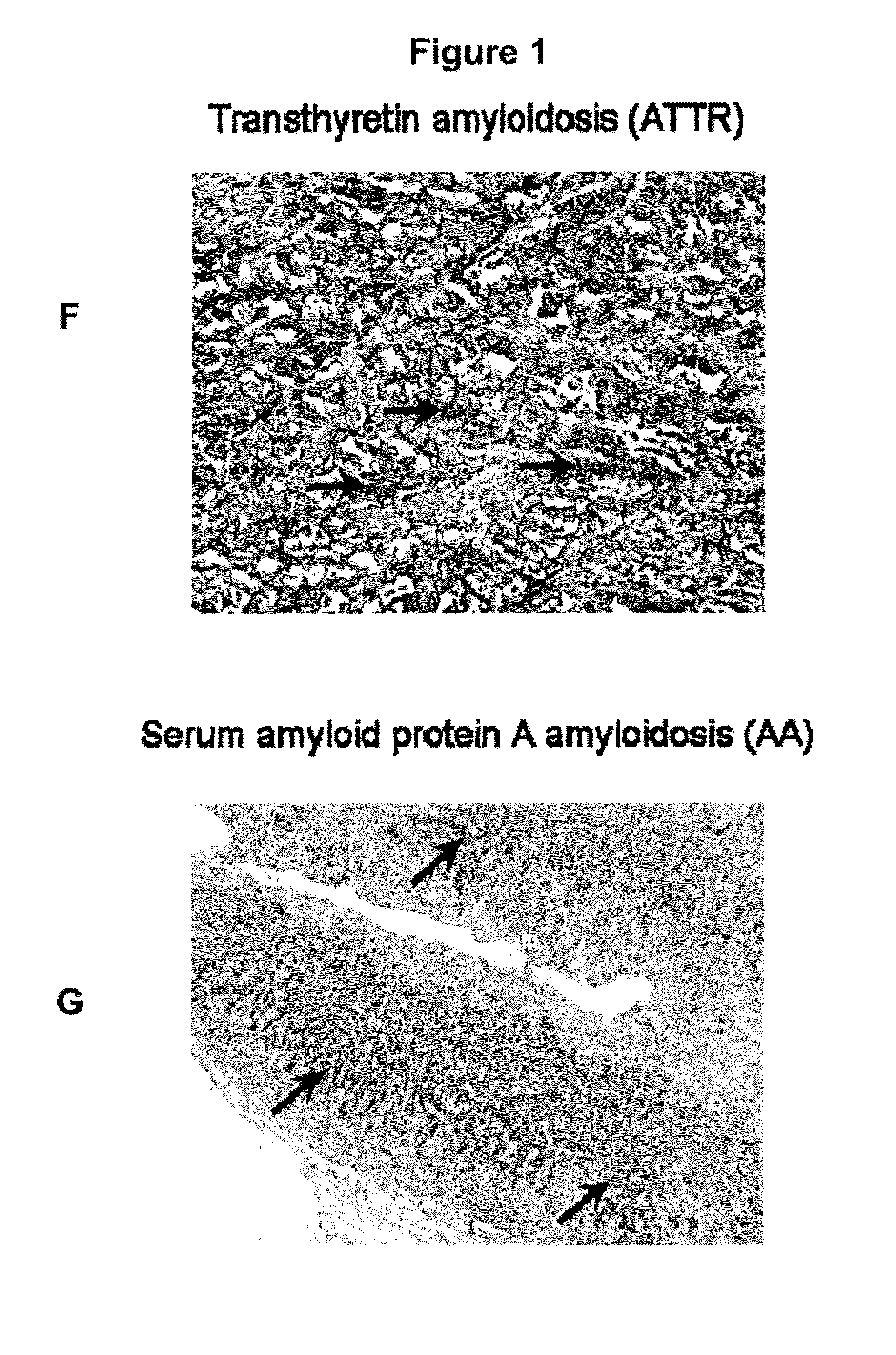Peptides that Specifically Target Amyloid Deposits
a technology of amyloid deposits and peptides, applied in the field of peptides, can solve the problems of inability to effectively diagnose, severe morbidity or death, organ dysfunction,
- Summary
- Abstract
- Description
- Claims
- Application Information
AI Technical Summary
Problems solved by technology
Method used
Image
Examples
example 1
125I-Labeled, Heparin-Reactive Protamine as a Novel Amyloid Imaging Reagent
[0127]Amyloid deposits contain, in addition to protein fibrils, a significant concentration of heparan sulfate proteoglycans (HSPG). Data suggest that the chemical structure of amyloid-associated heparan sulfate differs from that found ubiquitously in the ECM of essentially all normal tissues. Based upon these observations and the findings that certain HS-reactive scFv selectively bind amyloid deposits in AA mice and did not accumulate significantly in healthy tissues, the deposition of heparin-binding protamine in a transgenic mouse model of AA was investigated.
[0128]A heparin-binding peptide derived from protamine was synthesized, purified by reverse phase HPLC. Following radioiodination, 125I-labeled protamine (125I-protamine) was administered to animals with severe systemic AA amyloidosis mice or to amyloid-free mice and allowed to circulate for 1 hour, 2 hours, 4 hours, 8 hours or 24 hours. At each time ...
example 2
In Vivo and In Vitro Evaluation of Positively Charged Peptides as Amyloid Imaging Agents
[0130]Peptide tracers have proven to be excellent imaging biomolecules—they can be readily labeled with gamma and positron emitting nuclides (123I, ppmTc and 18F, 124I, respectively), are rapidly cleared from healthy tissues, are relatively immunologically silent, and can be easily manufactured according to GMP standards for human use. Furthermore, peptides can be readily manipulated to increase stability in circulation and affinity for the target pathology (i.e., multimerization and cyclization).
[0131]Based on the data obtained with protamines, in the Examples below, peptides that are positively charged are selected. They were labeled with radioiodine (I-125 and I-123) or technetium (Tc-99m) tested for in vivo binding to systemic AA amyloid deposits in the transgenic rapidly inducible amyloid disease (TRIAD) murine model by microSPECT or microPET imaging. The tissue biodistribution of each were ...
example 3
Peptide p31R
[0150]Design of Peptide p31R
[0151]Peptide p31R is a non-naturally occurring peptide. Peptide p31R was designed based on the amino acid sequence of peptide p31. It has been shown that when arginine replaces lysine in amphipathic alpha helices then these peptides have a greater propensity to form the helix and thus a greater propensity for ligand binding. Accordingly, peptide p31R was obtained by replacing lysine in the amino acid sequence of peptide p31 with arginine. The amino acid sequence of peptide p31R is
(amino acids 5-31 of SEQ ID NO: 4)SRAQRAQARQARQAQRAQRAQARQARQ.
[0152]The oligomer CGGY was added to the amino terminus of p31R for ease of labeling the peptide. Accordingly, the fusion peptide p31R has the following amino acid sequence:
CGGYSRAQRAQARQARQAQRAQRAQARQARQ(SEQ ID NO: 4)
[0153]Radiolabeling and In Vivo and In Vitro Evaluation of Peptide p31R
[0154]Peptide p31R was labeled in a similar manner as described above.
[0155]Peptide p31R was evaluated for its specific ...
PUM
| Property | Measurement | Unit |
|---|---|---|
| molecular weight | aaaaa | aaaaa |
| molecular weight | aaaaa | aaaaa |
| molecular weight | aaaaa | aaaaa |
Abstract
Description
Claims
Application Information
 Login to view more
Login to view more - R&D Engineer
- R&D Manager
- IP Professional
- Industry Leading Data Capabilities
- Powerful AI technology
- Patent DNA Extraction
Browse by: Latest US Patents, China's latest patents, Technical Efficacy Thesaurus, Application Domain, Technology Topic.
© 2024 PatSnap. All rights reserved.Legal|Privacy policy|Modern Slavery Act Transparency Statement|Sitemap



